Montérégie Connection: Ecosystem services in an agricultural landscape
The Montérégie. A conservation challenge.
The Land use and Development Plan (PMAD) of the Communauté Métropoliaine de Montréal (CMM) calls for the conservation of 17 percent of greater Montreal to maintain biodiversity.
Which green spaces should be conserved or restored to get the most benefit?
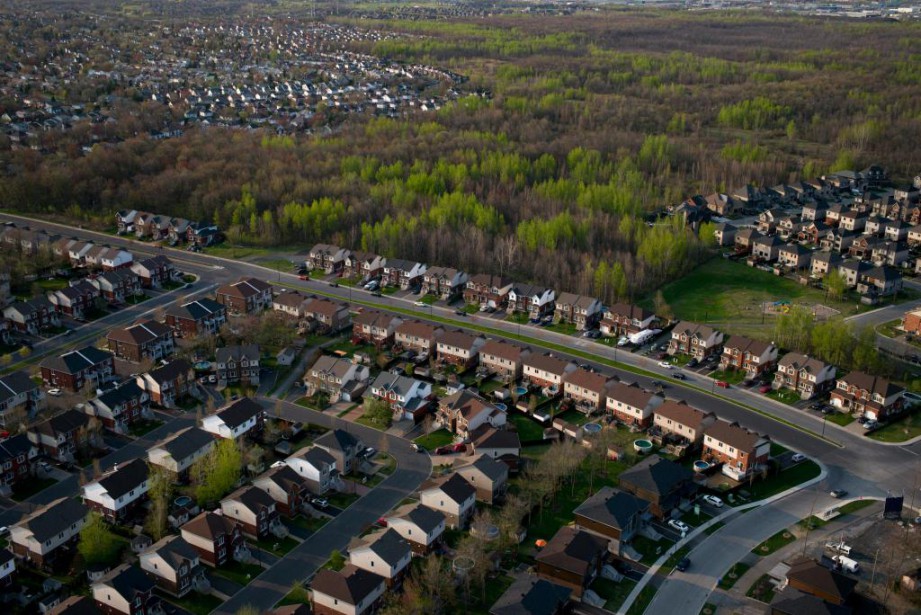
The Big Science Question
How are landscape configuration (the amount and location of different patches of habitat) and the provision of multiple ecosystem services linked in this landscape?
The map shows the location of sampling sites for four projects that each address important aspects of this question.
Scroll down to explore each of those projects!

How do small forest patches combat biodiversity loss and fight climate change?
How do forest fragments in the Monteregie affect ecosystem services in nearby agricultural fields?
Do wild bees promote pollination and fruit production in orchards?
How does forest fragmentation affect insect biodiversity in the treetops, and what are the consequences for ecosystem services in forest patches?
How do small forest patches combat biodiversity loss and fight climate change?
With Carly ZiterStudy design
We set up linear transects from the edge to interior of 24 different forest patches, and measured tree species and size to calculate tree diversity and carbon stocks.
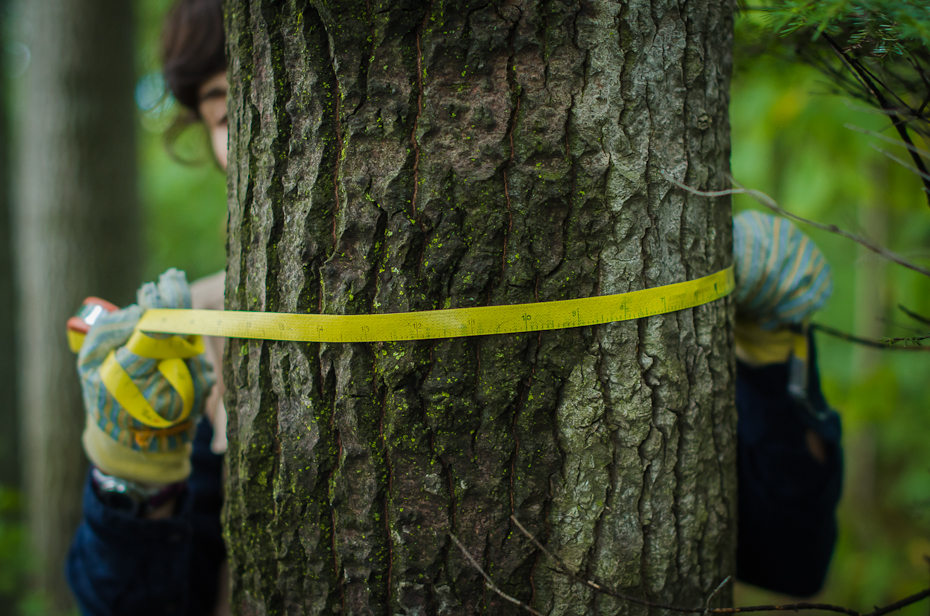
Small Woodlots - A key role!
Small fragments of forest play an important role in regional diversity and carbon storage, making woodlots an important part of conservation in this region.

Carbon, Management and Biodiversity
We observed both synergies and tradeoffs between biodiversity and carbon stocks, depending on forest management. Unmanaged forest stands stored less carbon on average than those that were managed (e.g., for maple syrup production), but demonstrated a positive relationship between functional diversity and aboveground carbon stocks. Managed stands exhibited a negative relationship between carbon and tree biodiversity, demonstrating that anthropogenic influence can alter the link between biodiversity and carbon stocks in natural systems.
Link to scientific article.
How do forest fragments in the Monteregie affect ecosystem services in nearby agricultural fields?
With Matthew MitchellStudy design
We measured ecosystem services - including crop production, pest regulation, soil fertility, carbon storage, and water quality regulation — at increasing distances from forest fragments in soybean fields.

Ecosystem services, distance from forests and isolation
Ecosystem services were affected by both distance-from-forest and the degree to which the forest fragment was isolated from other woodlots. This highlights the importance of actively managing forest fragments and considering location on the landscape to increase the multiple benefits of woodlots in agricultural landscapes.
Each ecosystem service showed its own distinct pattern of provision as landscape structure varied, thus providing evidence that landscape heterogeneity — the variety of forest and field types present in the landscape — is critical to ensure the provision of multiple ecosystem services.
Link to scientific article

Do wild bees promote pollination and fruit production in orchards?
Which near-orchard habitats are most important for apple-pollinating bees?
With Kyle Martins
Study design
We studied the pollination of apple, blueberry and raspberry crops by wild bees at 58 orchards in the Montérégie.
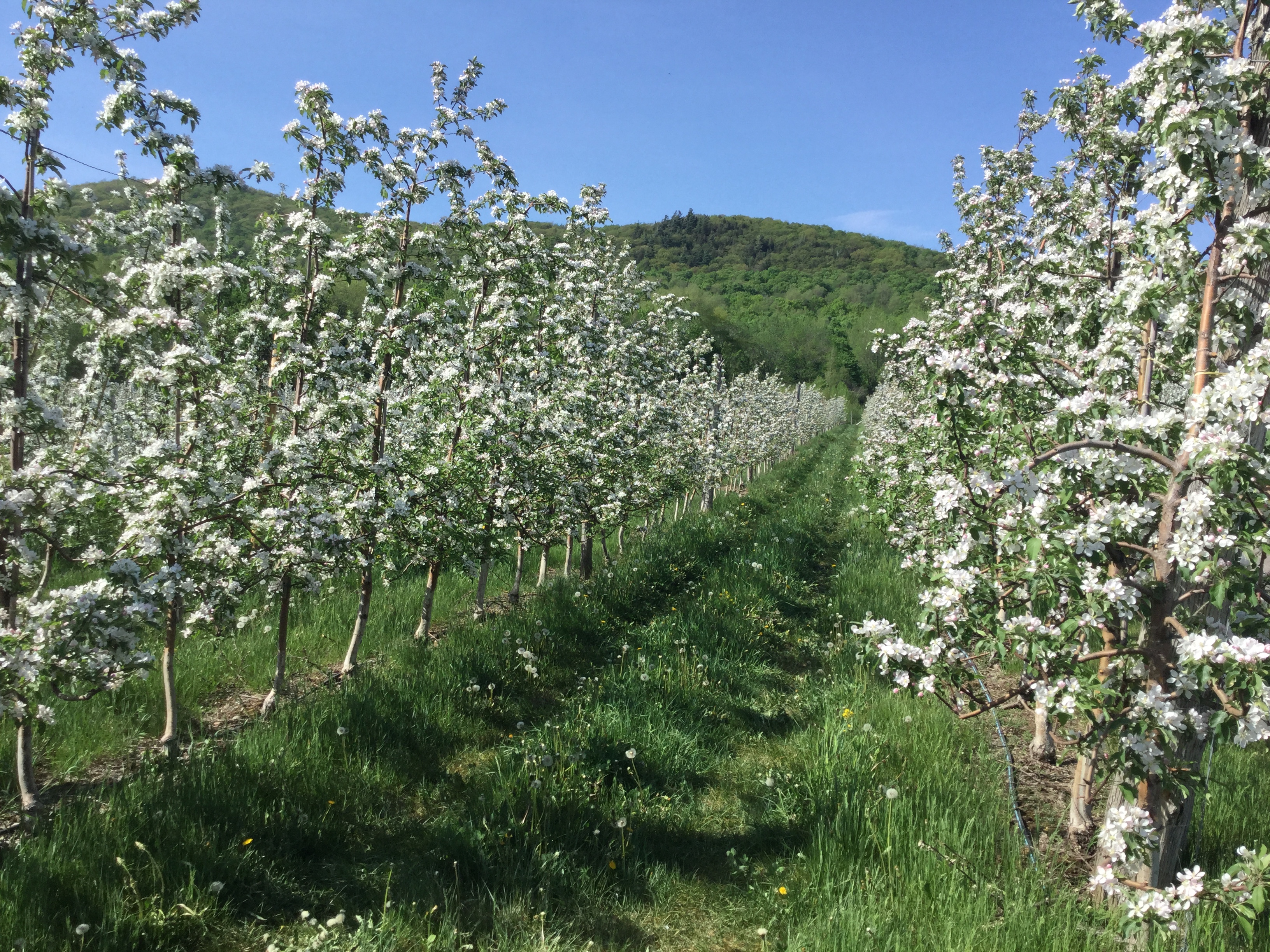
Bees play a key role in orchards
The amount of apples produced and the number of seeds in those apples increased with increasing functional diversity of bees. Conserving wild bee habitats near orchards can help secure crop pollination by encouraging a greater diversity of bees.
Apple fruit set and seed set was higher in orchards high more bee diversity. Complementarity between managed and unmanaged bees drove this relationship. Orchards with bee habitats (meadows, forests) nearby had higher bee diversity when crops were in bloom.
Link to scientific article
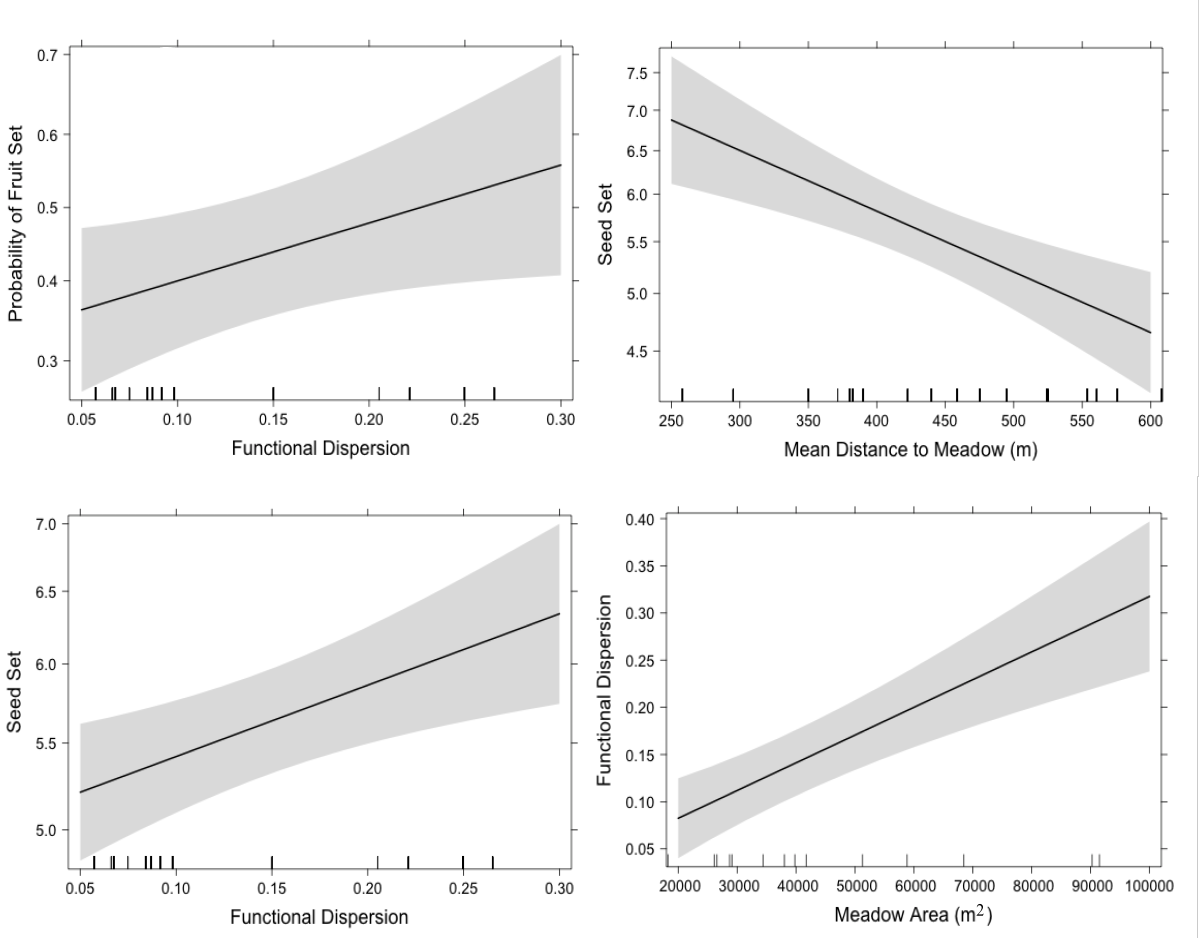
How does forest fragmentation affect insect biodiversity in the treetops, and what are the consequences for ecosystem services in forest patches?
With Dorothy MaguireStudy design
We climbed to the treetops to measure insect biodiversity and feeding activity on trees in forest patches varying in size and in their connection to other patches.
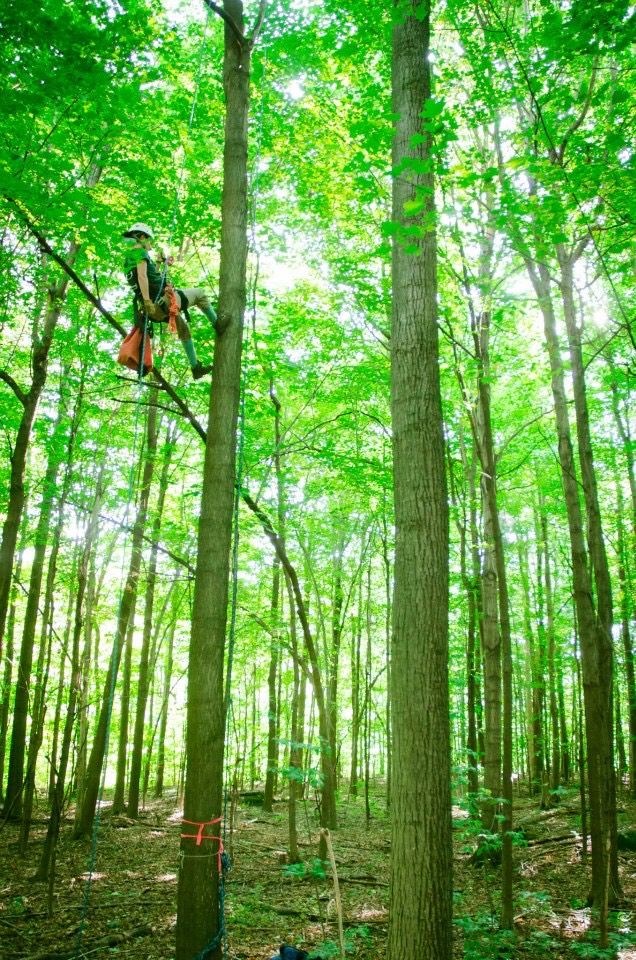
Forest patches as reservoirs of biodiversity
Forest fragmentation mediates the impact of insect biodiversity on ecosystem services, but even small forest patches were essential reservoirs of biodiversity.
Small forest patches were found to be essential reservoirs for insect biodiversity. Increased forest fragment connectivity reduced arthropod pest control in maple tree stands and mediated edge and canopy effects on insect herbivory.
Link to scientific article

Landscape structure, the spatial pattern of landscape elements and the connections between the different ecosystems or landscape elements, plays an important and varied role in ecosystem service provision.
It is important for landscape management to take landscape structure into account to effectively manage multiple ecosystem services.Scenario development
But what does this mean for the future of the region? The landscape structure-ecosystem service relationships are complex, and the implications, and outcomes of different management strategies are not always immediately obvious.
Scenarios – sets of stories about possible futures for a region – can be helpful for exploring these outcomes. We worked with key local stakeholders, including the Union de Producteurs Agricole, the Chambre de Commerce, the Centre de la Nature de Mont Saint Hilaire, Ouranos, Nature Action Québec, and more, to explore possible futures for this region and the outcomes for ecosystem services.

The Vallée-de-Richelieu Muncipalité Region Comté in the Whole-System Crisis scenario.
In this scenario an economic crisis drives residential densification while the Asian Long-Horned Beetle (Anoplophora glabripennis) invades, decimating the maple tree populations. Agricultural production shifts to pasture-based livestock, while marginal farmlands are converted to agroforestry.
The Demand For Energy scenario.
In this scenario shale gas development expands, resulting in farmland loss, while urban and residential development is limited. Wind power installations are also developed.
The Periurban Development scenario.
In this scenario increased residential growth drives loss of farmland and forests, resulting in loss of landscape connectivity and agricultural production in certain areas.
The Green Development scenario.
Here there is a shift toward sustainable development, where renewable energy, green tramways, green corridors, protected areas, and agriculture that incorporates agroforestry principles are emphasized.
What's next?
We're pursuing these questions and more in a series of working landscapes across Canada. You can learn more about NSERC ResNet, at nsercresnet.caThe work presented here was a larger project made up of work done by a large group of graduate students, postdoctoral scholars, and undergraduates, including:
Postdoctoral Scholars: Cecile Albert,Sylvestre Delmotte, Delphine Renard, and Marta Terrado.
Graduate students: Martine Larouche, Kate Liss, Dorothy Maguire, Matt Mitchell, Kyle Martins, and Carly Ziter
Undergraduates and technical staff include: Max Luke, Emery Hartley, Emily Pedersen, Katrina O’Kane, Tereza Jarnikova, Claudia Atomei, Thomas Nicole, Marissa Nolan, Yelena Zhimbey, Brianna Levenstein, Carhlotte Lapeyre, Piumi Abeynayaka, Natasha Salter, Natasha Dudek, Divya Sharma, Sara Saldanha, Rebekah Kipp, Shauna Mahajan, Lucie Taliana, Hsin Hui Huang, Aaron Ball, and Karine Dancose.
References
Felipe-Lucia, M. R., F. A. Comin, and E. M. Bennett. 2014.Interactions among ecosystem services across land uses in a floodplain agroecosystem. Ecology and Society Society 19 (1): 20.
Lamy, T. Liss, K., E. M. Bennett, and A. Gonzalez. 2016. Landscape structure affects the provision of multiple ecosystem services. Environmental Research Letters 11: 124017.
Liss, K.N., Mitchell, M.G.E., MacDonald, G.K., Mahajan, S., Méthot, J., Jacob, A.L., Maguire, D., Metson, G., Ziter, C., Dancose, K., Martins, K., Terrado, M., and Bennett, E.M. 2013. Variability in ecosystem service measurement: a pollination service case study. Frontiers in Ecology and the Environment 11(8):414–422.
Maguire, DY, EM Bennett, and CM Buddle. 2016. Sugar maple tree canopies as reservoirs for arthropod functional diversity in forest patches across a fragmented agricultural landscape in southern Quebec, Canada. Ecoscience 23
Maguire D.Y., Buddle, C.M., and E.M. Bennett. 2016. Within and among patch variabillty in patterns of insect herbivory across a fragmented forest landscape. PLoSONE 11(3): e0150843
Maguire, D.Y., James, P.M.A., Buddle, C.M., and E.M. Bennett. 2015. Landscape connectivity and insect herbivory: A framework for understanding tradeoffs among ecosystem services. Global Ecology and Conservation: 73-84.
Maguire, D. Y., T. Nicole, C. Buddle, and E. M. Bennett. 2015. Effect of fragmentation on predation pressure of insect herbivores in a north temperate deciduous forest ecosystem. Ecological Entomology 40: 182-186.
Martins, K. T., Gonzalez, A., and M. J. Lechowicz, (2015) Pollination services are mediated by bee functional diversity and landscape context. Agriculture, Ecosystems and Environment 200: 12-20.
Martins, K.T., C.H. Albert, M.J. Lechowicz, A. Gonzalez. 2018. Complementary crops and landscape features sustain wild bee communities, Ecological Applications 28: 1093-1105
Martins, K.T., A. Gonzalez and M.J. Lechowicz. 2017. Patterns of pollinator turnover and increasing diversity associated with urban habitats, Urban Ecosystems 20: 1359-1371
Mitchell, MGE, A. Gonzalez, and E. M. Bennett. 2015. Strong and nonlinear effects of fragmentation on ecosystem service provision at multiple scales. Environmental Research Letters 10: 094014.
Mitchell, M. G. E., E. M. Bennett, and A. Gonzalez. 2014. Agricultural landscape structure affects arthropod diversity and arthropod-derived ecosystem services. Agriculture, Ecosystems, and Environment 192: 144-151
Mitchell, M. G. E. , E. M. Bennett, and A. Gonzalez. 2014. Forest fragments modulate the provision of multiple ecosystem services in an agricultural landscape. Journal of Applied Ecology 51: 909-918.
Mitchell, M.G.E., E. M. Bennett, and A. Gonzalez. 2013. Linking landscape connectivity and ecosystem service provision: current knowledge and research gaps. Ecosystems 16: 894-908.
Mitchell, MGE E M. Bennett, A Gonzalez, M Lechowicz, J Rhemtulla, JA Cardille, K Vanderheyden, G Poirier-Ghys, D Renard, S Delmotte, C Albert, B Rayfield, M Dumitru, H-H Huang, R Kipp, M Larouche, K Liss, D Maguire, K Martins, M Terrado, C Ziter, L Taliana, K Dancose. 2015. Montérégie Connection: Connecting landscape structure, biodiversity, ecosystem services, and stakeholders at multiple scales for decision-making. Ecology and Society 20(4): 15.
Renard, D., J. Rhemtulla, and E. M. Bennett. 2016. Agro-biodiversity has increased over a 95 year period at sub-regional and regional scales in southern Quebec, Canada. Environmental Research Letters 11: 12404.
Renard, D., J. M. Rhemtulla, and E.M. Bennett. 2015. Historical dynamics in ecosystem service bundles. Proceedings of the National Academy of Sciences. 112 (43): 13411-13416.
Terrado, M, R Tauler, and E. M. Bennett. 2014. Local and landscape factors influence water purification in the Monteregian agroecosystem in Quebec, Canada. Regional Environmental Change 15(8): 1743-1755.
Villamagna, A. M., P. L. Angermeier, and E.M. Bennett. 2013. Capacity, pressure, demand, and flow: A conceptual framework for analyzing ecosystem service delivery. Ecological Complexity 15: 114–121.
Ziter, C., A. Gonzalez, and E. M. Bennett. 2013. Functional diversity and management mediate carbon storage in small forest fragments. Ecosphere 4(7): 85.Ziter, C., A. Gonzalez, and E. M. Bennett. 2014. Temperate forest fragments maintain aboveground carbon stocks out to the forest edge despite changes in community composition. Oecologia 176: 893-902